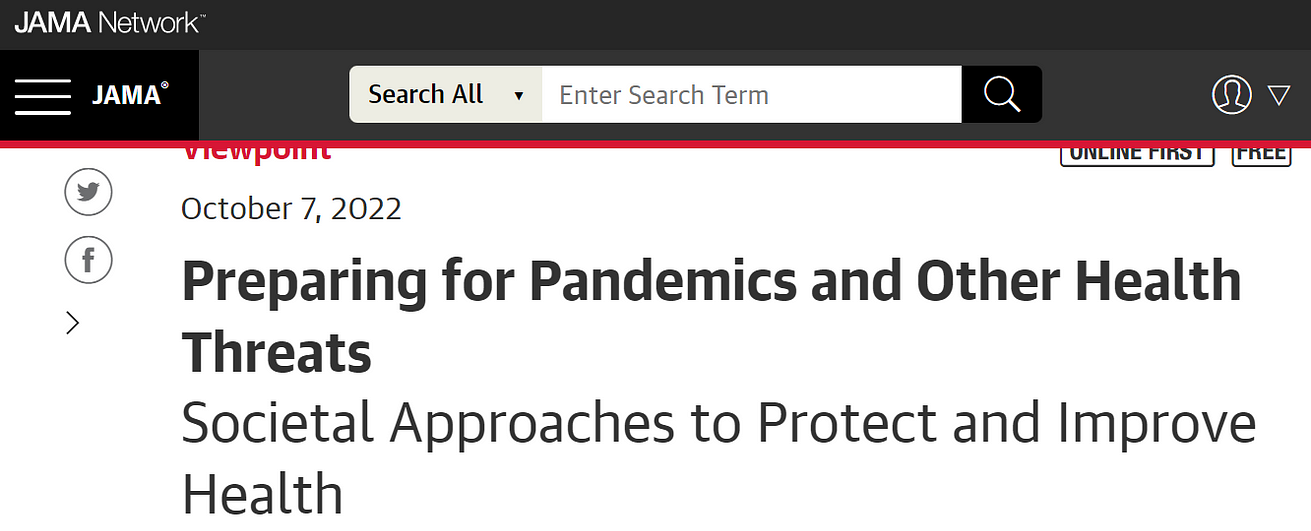Societal Approaches to Protect and Improve Health
Site editor:
Joaquim Cardoso MSc
health transformation institute (HTI) — research and strategy
October 7, 2022
JAMA Network
Thomas R. Frieden, MD, MPH1;
Amanda McClelland, RN, MPH1
October 7, 2022
Dr. Tom Frieden served as Director of the Centers for Disease Control and Prevention, and Commissioner of the New York City Health Department.
EXECUTIVE SUMMARY (by the site editor):
Overview:
The devastating human, economic, social, and educational costs of the COVID-19 pandemic illustrate the risks of insufficient preparedness.
- Countries failed to prevent millions of deaths and tens of millions of severe illnesses, hundreds of millions of students fell behind on their education, and there has been trillions of dollars in economic damage.1
- The world remains unprepared for and unprotected from disease outbreaks.
To prevent avoidable illness and death from the next pandemic, and to improve health and productivity regardless of when the next deadly variant or microbe emerges, societies need progress in 3 areas:
- a renaissance in public health;
- robust primary health care at the center of health care systems; and
- resilience so people are healthier and communities trust health care and other public services and are thus better able to withstand and effectively respond to health threats.
Conclusions
Public health and primary health care systems must work together to strengthen the population’s trust.
- Trust cannot be surged during a health emergency.
- Building and maintaining community trust will strengthen the ability to detect disease outbreaks rapidly and respond effectively.
- Faster and more effective public health action is needed, with real-time surveillance, better communication and community engagement, and rapid response capacity.
- Improved primary health care can address symptomatic conditions as well as the leading drivers of disability and death.
- Environments can be structured to make healthy choices the default choices.
Financial, social, and political challenges as well as competing priorities, including security, climate change, and economic recession, will make it difficult to stay the course.
- It will be important to share lessons and resources among and within countries, in the recognition that collaboration is essential for progress against our common microbial enemies.
- Collaboration to improve public health, primary care, and community resilience is the route — and perhaps the only route — to healthier, more productive societies better prepared for future pandemics and other health threats.
What is the investment required
ORIGINAL PUBLICATION (full version)

JAMA Network
Thomas R. Frieden, MD, MPH1; Amanda McClelland, RN, MPH1
October 7, 2022
Public Health Renaissance
For a public heath renaissance, increased and stable local, state, national, and global funding, rigorous management informed by real-time data from clinical and nonclinical sources, active engagement of all segments of each community, and addressing inequities are all essential.
The World Health Organization needs stronger authorities and a larger, more flexible budget.
According to one estimate, governments and private-sector partners need to provide low- and middle-income countries with at least $5 billion more per year for at least the next 5 to 10 years to substantially increase preparedness.2
It will be a challenge to both raise the necessary funds and improve mechanisms for their distribution and spending.
According to one estimate, governments and private-sector partners need to provide low- and middle-income countries with at least $5 billion more per year for at least the next 5 to 10 years to substantially increase preparedness.2
A new World Bank financial intermediary fund has raised $1.4 billion in initial commitments to address pandemic preparedness.
Unless governance of the fund includes appropriate representation from countries receiving funds, a focus on sustained improvement in core public health capacities, and assurance of accountability to countries providing funds, it is not likely to succeed.
Furthermore, it is essential that expert staff well practiced in prevention, detection, and response are in place at national and subnational levels; no amount of vaccines, medications, protective equipment, and other items, will make the world sufficiently safe without adequate staff.3
Mechanisms to spend quickly and well, such as the principal recipient mechanism of the Global Fund and fiscal intermediaries to provide efficient administrative services and facilitate rapid hiring of staff could help enable efficient and transparent implementation.
Rigorous management of public health programs requires a culture of continuous quality improvement.
How fast a system detects and responds effectively to a threat is the optimal measure of performance.
The 7–1–7 framework for early outbreak detection, notification, and response complements existing preparedness measures, with the goal to
- identify every outbreak within 7 days of emergence,
- report it to public health authorities and begin outbreak control within 1 day, and
- have all essential control measures in place within 7 days.4
The 7–1–7 metric provides a means to assess and advocate for resources that improve preparedness and is also a tool for rapid quality improvement.
To meet this target, much more sensitive surveillance systems, improved diagnostic capacity and expertise, and enhanced rapid response capacity are required.
These all rely on stronger connections between the public health and health care systems.
Public health systems must combine traditional skills including case investigation, contact tracing, and epidemiologic analysis with upgrades in technologies, such as wastewater surveillance, analysis of large data sets, and improvements in capacity to engage every community to deliver vaccines, treatments, and education.
Public health systems must combine traditional skills including case investigation, contact tracing, and epidemiologic analysis with upgrades in technologies, such as wastewater surveillance, analysis of large data sets, and improvements in capacity to engage every community to deliver vaccines, treatments, and education.
These improvements could enable public health to rebuild public trust, which was damaged by an inadequate pandemic response and, in many countries, politicization of public health interventions.
Effective public health agencies map the communities they serve and identify subgroups potentially disconnected from health care or broader public services.
They then engage community leaders and influencers to increase mutual understanding and address, to the greatest extent possible, leading community concerns and provide messaging specific to their populations.
Building and maintaining trust will be essential to reduce the risk of missing an outbreak before it spreads widely, and increases the likelihood control measures will be adopted in the community when needed.
In addition to providing effective public health services, including safe food, water, and air, one effective way to increase community trust is to provide accessible, affordable, and effective primary health care services.
In addition to providing effective public health services, including safe food, water, and air, one effective way to increase community trust is to provide accessible, affordable, and effective primary health care services.

Robust Primary Health Care
Primary health care is essential to improve the health of individuals and populations, but it is the most neglected part of many health care systems in the United States and globally.
Epidemic-ready primary health care is central to protecting communities from infectious disease outbreaks and promoting community resilience against health threats.
Epidemic-ready primary health care protects health care workers and patients.
Despite the critical importance of primary health care, it is often the weak link in community and national response.
Financing reforms are needed to strengthen primary health care systems to improve both routine care and response to health emergencies.5,6
Financing reforms are needed to strengthen primary health care systems to improve both routine care and response to health emergencies
Optimally, primary health care systems assign every person in a community to a specific primary health care clinician who leads a multidisciplinary team that provides patient-centered care, …
… with clinical encounters at times and places convenient to patients and out-of-pocket costs minimized or eliminated.
Patients receive care over years by the same team (although team members might change), which has ready access to diagnostic testing as well as referral for specialist care and hospitalization when indicated.
Optimally, primary health care systems assign every person in a community to a specific primary health care clinician who leads a multidisciplinary team that provides patient-centered care, …
… with clinical encounters at times and places convenient to patients and out-of-pocket costs minimized or eliminated.
Primary health care systems need sustained funding, including for staff and facilities, particularly in rural and underserved areas.
Payment reforms, including well-designed performance incentives and a shift toward capitation, can improve patient outcomes.6
A culture of quality monitoring and continuous improvement is a consistent characteristic of the highest-performing primary health care systems.
Most outbreaks are identified by alert clinicians who are connected with their local public health system; strengthening the systems to improve clinician performance and build connections with public health will be essential.
Well-performing primary health care systems can benefit from virtuous cycles.
Where primary health care provides high-quality care (eg, accessible with low out-of-pocket expenses and respectful treatment of patients), people appreciate and increasingly use services.
Political leaders recognize the political and societal benefit of improving primary health care and further increase funding, enabling physicians, other health care professionals, and health care organizations to further improve services, resulting in even greater community appreciation and utilization of and political and budgetary support for primary health care.
Advocacy from patient groups and health care workers has been an important catalyst for progress.
As this cycle continues and gains momentum, the primary health care system can achieve escape velocity, escaping political partisanship and the cycle of limited services leading to limited support as it gains recognition as a national priority and resource.
The United Kingdom, Thailand, Costa Rica, and Sri Lanka have achieved this, with primary health care services supported by budgets that are endorsed by nearly all political parties and governments.7

Resilient Individuals and Communities
By the end of 2022, COVID-19 will have resulted in more than an estimated 20 million excess deaths worldwide.8
One reason COVID-19 has been so deadly is that so many people were vulnerable due to their poor health status, and many communities — defined by geography, political affiliation, race, ethnicity, and other factors — were disconnected from health care and government services.
Long-standing health disparities based on race and other factors, exacerbated during the pandemic, must be addressed much more effectively.
More resilient individuals and communities with higher levels of trust in government and society are better able to withstand health threats of all types.
One reason COVID-19 has been so deadly is that so many people were vulnerable due to their poor health status, …
… and many communities … were disconnected from health care and government services.
Resilience is strengthened when environments are structured to make healthy behaviors the default choice.
Community-wide interventions that improve health include
- high and increasing taxes on tobacco, alcohol, and unhealthy food;
- reduced contamination of air and water;
- policies that reduce disparities and inequalities;
- land use policies that promote physical activity such as bicycling and walking; and food policies that encourage healthier eating, including eliminating artificial trans fat and reducing sodium consumption.
Environments structured to reduce avoidable illness, injury, disability, death, and health disparities also could help reduce risk and harm from future health emergencies.9

Conclusions
Public health and primary health care systems must work together to strengthen the population’s trust. Trust cannot be surged during a health emergency. Building and maintaining community trust will strengthen the ability to detect disease outbreaks rapidly and respond effectively. Faster and more effective public health action is needed, with real-time surveillance, better communication and community engagement, and rapid response capacity. Improved primary health care can address symptomatic conditions as well as the leading drivers of disability and death. Environments can be structured to make healthy choices the default choices.
Financial, social, and political challenges as well as competing priorities, including security, climate change, and economic recession, will make it difficult to stay the course. It will be important to share lessons and resources among and within countries, in the recognition that collaboration is essential for progress against our common microbial enemies. Collaboration to improve public health, primary care, and community resilience is the route — and perhaps the only route — to healthier, more productive societies better prepared for future pandemics and other health threats.
About the authors & affiliations
Thomas R. Frieden, MD, MPH1;
Amanda McClelland, RN, MPH1
1 Resolve to Save Lives, New York, New York
References and additional information:
See the original publication: https://jamanetwork.com












